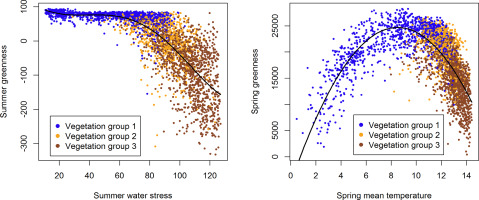Science of the Total Environment ( IF 9.8 ) Pub Date : 2018-10-11 , DOI: 10.1016/j.scitotenv.2018.10.052 C. Piedallu , V. Chéret , J.P. Denux , V. Perez , J.S. Azcona , I. Seynave , J.C. Gégout

|
Several studies use satellite-based normalized difference vegetation index (NDVI) to monitor the impact of climate change on vegetation covers. Good understanding of the drivers of NDVI patterns is hindered by the difficulties in disentangling the effects of environmental factors from anthropogenic changes, by the limited number of environmental predictors studied, and by the diversity of responses according to periods and land covers. This study aims to improve our understanding of the different environmental drivers of NDVI spatial variations for different stand type characteristics of mountain and Mediterranean biomes. Using NDVI values extracted from MODIS Terra time series, we calculated Spring Greenness (SG) and annual Relative Greenness (RGRE) to depict spring and summer vegetation activity, respectively, in a contrasted area of 10,255 km2 located in the south of France. We modeled SG and RGRE at different scales, using 20 environmental predictors characterizing available energy, water supply, and nutrient supply calculated for different periods of the year. In spring, high minimum temperatures, good nitrogen availability, and acidic or neutral pH turned out to be determining for greenness, particularly for stand types located in altitude. In summer, an important soil water reserve and low temperatures promoted vegetation dynamics, particularly for stands located in areas with a Mediterranean climate. Our results show that NDVI dynamics was not only driven by climatic variability, and should not be studied using only mean temperature and rainfall. They highlight that different environmental factors act complementarily, and that soil parameters characterizing water stress and soil nutrition should be taken into account. While the factors limiting NDVI values varied according to the season and the position of the stands along the ecological gradients, we identified a global temperature and water-stress threshold when considering the whole vegetation.
中文翻译:

根据季节和林分类型,土壤和气候对NDVI模式的影响不同
多项研究使用基于卫星的归一化植被指数(NDVI)来监测气候变化对植被覆盖的影响。由于难以区分人为因素引起的环境因素的影响,研究的环境预测因子数量有限以及根据时期和土地覆盖而做出的响应多样性,阻碍了对NDVI模式驱动因素的良好理解。这项研究旨在增进我们对山区和地中海生物群落不同林分类型特征的NDVI空间变化的不同环境驱动因素的理解。使用从MODIS Terra时间序列中提取的NDVI值,我们计算了春季绿度(SG)和年度相对绿度(RGRE)来分别描述在10,255 km的对比区域中的春季和夏季植被活动2个位于法国南部。我们使用20个环境预测因子对SG和RGRE进行了不同规模的建模,这些预测因子表征了一年中不同时期计算的可用能源,水和营养供应。春季,最低温度高,良好的氮素利用率以及酸性或中性pH值决定了绿色,特别是对于海拔高度较高的看台类型。在夏季,重要的土壤水储量和低温促进了植被动态,特别是对于地中海气候地区的林分。我们的结果表明,NDVI动态不仅受气候变化的驱动,而且不应仅使用平均温度和降雨来研究。他们强调,不同的环境因素可以相互补充,并应考虑表征水分胁迫和土壤营养的土壤参数。虽然限制NDVI值的因素会根据季节和林分沿生态梯度的位置而变化,但在考虑整个植被时,我们确定了全球温度和水分胁迫阈值。



























 京公网安备 11010802027423号
京公网安备 11010802027423号